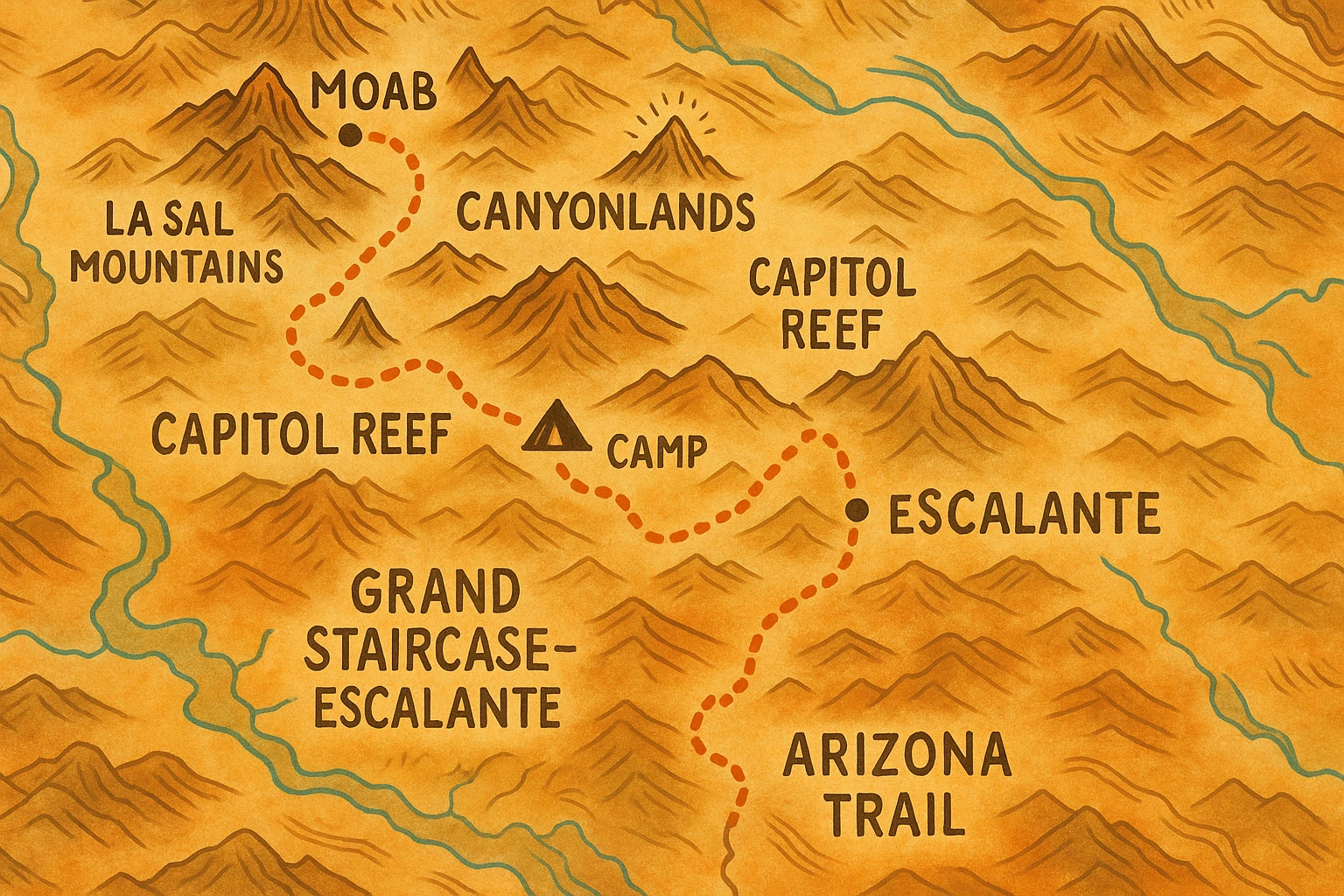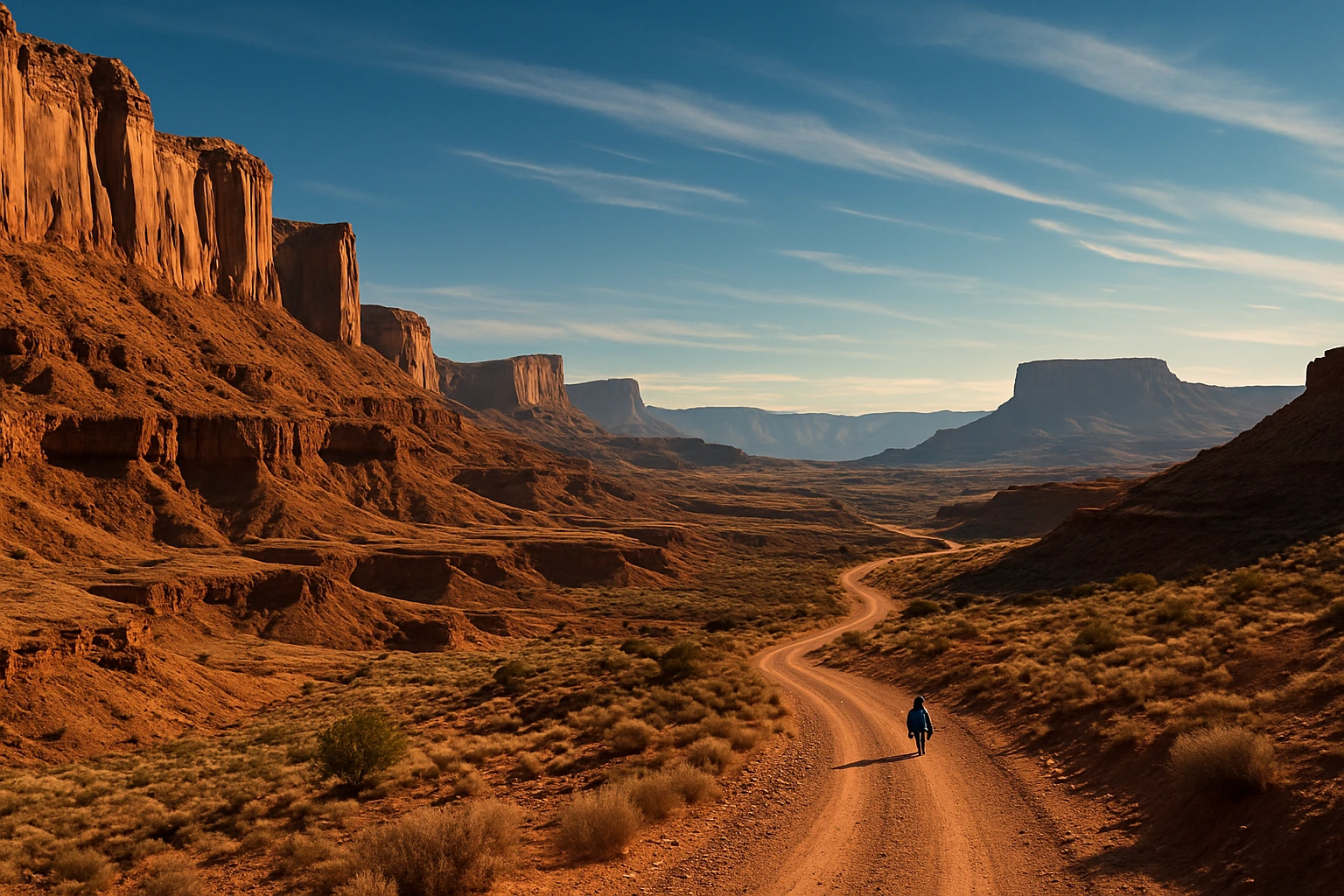
Picture this: I’m stuck in the Utah desert, water bottles bone-dry, sun frying my back. That’s when I realized bikepacking Western US lessons learned would shape the whole ride. I kept pedaling through red rock and big sky, and the miles taught me more than any forum thread. If you’re new to the basics, start with the fundamentals and layer in the desert tweaks.
This is the raw stuff: the worst mistakes I made (so you can skip ’em), the gear that saved my hide, and the lessons on prep, grit, and the magic of a well-timed burrito. 🌯 For route ideas, browse Bikepacking.com.
Check Your Desert ReadinessTable of Contents
- Why the West Hooked Me
- Route Overview (Moab → AZ & NV desert)
- Desert Gear That Actually Worked
- My Worst Desert Mistakes (and fixes)
- Are You Desert-Ready? Quick Assessment
- What Actually Worked Out There
- Mental Prep for Long Desert Days
- Desert-Specific Tips
- Frequently Asked Questions
- Conclusion: The Desert’s Worth It
Why the West Hooked Me
For years, I pored over maps of the American West. The desert’s stark beauty, the promise of solitude, and the challenge of self-sufficiency drew me in. I craved a test of my limits, a break from the digital world, and a connection with landscapes only a bike could offer. My journey became a quest to find meaning on the road, much like the insights shared there.
Meanwhile, the West became more than a place—it was a feeling. The wind whispered through canyons. The sun seared my skin. The desert night hummed quietly. It’s where you find yourself… or at least discover your granola bar limit.
Route Overview (Moab → AZ & NV desert)
My route wasn’t a single trail but a patchwork of dirt roads, gravel paths, and pavement linking iconic Western landscapes. It blended parts of the Arizona Trail, the Great Western Trail, and some hidden gems I stumbled upon.
- Starting Point: Moab, Utah 🏜️
- Key Destinations: Canyonlands National Park, Capitol Reef National Park, Grand Staircase-Escalante, Arizona Trail sections, remote Nevada
- Total Distance: ~1200 miles
- Duration: 6 weeks
- Terrain: Gravel, dirt roads, sandy sections, rocky climbs

Desert Gear That Actually Worked
Here’s what actually worked, what failed, and what I’d pack again for the desert.
Standout Gear on This Route
Selecting reliable gear can make or break your trip, as I learned the hard way. For more recommendations, check out that guide.
- Reliable Bike: My Surly Bridge Club was a beast, with a sturdy frame for long days.
- Tires: Maxxis Ikon 2.2″ tubeless tires balanced speed and traction.
- Hydration: Water bottles, a CamelBak, and a Sawyer Squeeze filter kept me hydrated.
- Navigation: A Garmin eTrex GPS and paper maps were lifesavers in remote areas.
- Sun Protection: SPF 50 sunscreen, a wide-brimmed hat, and sunglasses were must-haves.
- Repair Kit: Tools, spare tubes, patches, and a chain tool fixed multiple breakdowns.

Gear Lessons Learned for Bikepacking
Capturing the desert’s beauty was a bonus, but it required lightweight gear. I wish I’d known the tips for adventure photography before packing my camera.
- Clothing: Merino wool is breathable and odor-resistant. Pack a fleece and windbreaker for temperature swings.
- Sleeping System: A lightweight tent, sleeping bag (rated 20°F below expected lows), and pad ensured comfort.
- Cooking: A small stove and pot made hot meals. Choose calorie-dense foods like nuts.
- First Aid: Include pain relievers, antihistamines, and stomach meds.
- Electronics: A power bank and solar charger kept devices alive.
Food Planning That Kept Me Moving
I aimed for 4–5k daily calories, leaning on pocketable, calorie-dense staples—peanut-butter packets, dehydrated meals, and a rotation of bars and trail mix. I planned town resupplies in places like Moab and Escalante, and kept two extra days of food in case weather or terrain slowed me down.
Gear Checklist for the Desert Ride
Interactive Gear Checklist
Check off essential items to ensure you’re prepared for desert bikepacking.
Essential Gear Table
| Item | Why It’s Essential | Notes |
|---|---|---|
| Water Filter | Clean water is scarce. | Sawyer Squeeze; backwash often. |
| Sunscreen SPF 50 | The sun is relentless. | Reapply every 2 hours. |
| Wide-Brimmed Hat | Protects face and neck. | Choose one with a neck cape. |
| Repair Kit | Mechanical issues are common. | Practice repairs beforehand. |
| Merino Wool Socks | Prevents blisters. | Invest in 2–3 pairs. |
| GPS Device | Prevents getting lost. | Download offline maps. |
| Extra Batteries | Powers GPS and lights. | Carry spares. |
| Duct Tape | Fixes nearly anything. | Wrap around water bottle. |
| Cash | Small towns may not take cards. | Small bills make life easier. |
| Emergency Beacon | Calls help in no-service areas. | PLB or satellite communicator. |
“Gear is your lifeline in the desert. Choose wisely, pack light, and master your tools.”
My Worst Desert Mistakes (and fixes)
I messed up plenty, and those blunders taught me how to ride smarter in the desert.
Underestimating Desert Heat: Bikepacking Lessons
Mistake: In late spring, I thought I’d dodge the worst heat. Wrong. Temperatures hit 100°F, and I dehydrated fast, barely pedaling 10 miles.
Solution:
- Ride before sunrise to avoid peak heat.
- Rest in shade frequently.
- Plan roughly 4–6 liters daily, adjusting for heat, effort, and body size.
- Use electrolyte tablets to replace salts.
- Wear light-colored, loose clothing.
- Soak a bandana for cooling.
Water Shortages
Mistake: I trusted map-listed water sources, only to find them dry. Rationing my last sips was terrifying.
Solution:
- Call ranger stations to verify water sources, and review your park’s official safety page for current heat and hydration guidance.
- Carry 1 gallon/day, more in heat.
- Purify all natural water with a filter.
- Plan routes around reliable water.
Poor Route Planning for Bikepacking
Mistake: I assumed mapped roads were passable. Sandy washes and washed-out paths forced hours of pushing my bike.
Solution:
- Check road conditions via forums or locals.
- Prepare for hike-a-bike in sand.
- Have backup routes ready.
- Use offline maps for no-service areas.
Gear Breakdowns
Mistake: I skipped a pre-trip bike tune-up. A flat tire, broken spoke, and wonky derailleurs slowed me down.
Solution:
- Get a professional bike check.
- Learn to fix flats, chains, and derailleurs.
- Carry spare tubes and a spoke wrench.
- Use threadlocker on bolts.
Ignoring Physical Limits
Mistake: I ignored knee pain and saddle sores, pushing too hard. Riding became agony.
Solution:
- Take breaks when tired.
- Pace yourself; aim for steady miles.
- Stretch daily to prevent soreness.
- Ensure proper bike fit.
- Use chamois cream for saddle sores.
Are You Desert-Ready? Quick Assessment
Desert Bikepacking Prep Assessment
Gauge your readiness for Western US bikepacking with this tool.
What Actually Worked Out There
What paid off most was the unglamorous prep—weeks of route research and water checks—paired with flexibility on the ground. Rerouting became normal, and a good attitude turned rough stretches into stories. Advice from veteran riders helped, too. If you’re brand-new, start with Bikepacking 101 and then layer in the desert tweaks.

Mental Prep for Long Desert Days
One night under a starry sky, I doubted I’d finish. To stay strong:
- Set small goals: Focus on the next 10 miles, not the whole trip.
- Embrace solitude: Use quiet moments to reflect.
- Visualize success: Picture reaching the next town.
- Carry a morale booster: A playlist or journal helped me.
Desert-Specific Tips
The desert throws curveballs. I shook out my shoes each morning for rattlesnakes, pulled a buff over my face when dust kicked up, and avoided dry washes whenever rain showed up in the forecast. A little caution keeps the adventure fun.
Frequently Asked Questions
Carry more water than you think you’ll need, verify sources with rangers, start riding before sunrise, use electrolytes, bring a reliable GPS plus paper maps, and practice basic repairs. Flexibility matters—reroutes and realistic mileage help more than bravado.
Train for 3–6 months, focusing on endurance rides (20–50 miles) 3–4 times weekly. Include gravel or dirt paths to mimic desert terrain and practice carrying gear.
Spring (March–May) or fall (September–November) offer milder temperatures (60–80°F). Avoid summer’s extreme heat and winter’s cold nights.
Call the ranger station or check fresh trail reports on Bikepacking.com. Carry a filter and plan around verified sources; 1 gallon a day is a solid baseline.
Beginners can start with shorter routes (e.g., 50–100 miles) in less remote areas, like parts of the Arizona Trail, after learning basic bike maintenance and navigation.
Prioritize a water filter, GPS device, repair kit, and sun protection (sunscreen, hat). These ensure hydration, navigation, and safety in harsh conditions.
Conclusion: The Desert’s Worth It
These Western US bikepacking lessons transformed me. You’ll face heat, doubt, and the occasional breakdown, but also crimson sunsets, quiet nights, and a stronger version of yourself. Prepare well, verify water, start early, and ride your plan (not someone else’s). If you’re new to this, Bikepacking 101 is a great place to begin. Pack plenty of water, stash a spare burrito, and chase the horizon.
Trail conditions and desert heat can change quickly. This article shares personal experience, not professional advice. Check current park guidance and talk to local rangers before you go.